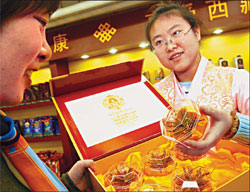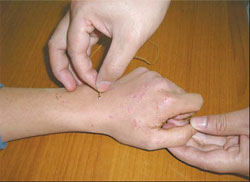Home-grown healing power
In a shop selling special local products at Xidan of Beijing, a sales girl is showing to a customer a box of wild Chinese caterpillar fungus, also known as "worm in winter and grass in summer", which grows on the Qinghai-Tibet Plateau and is an expensive medical material widely recognized for its healthful qualities. |
Since the 1980s more than 30 ethnic groups have honed their own medical experiences and given concerted attention to their distinctive traditions.
Six to eight systems of minority medical care, including Tibetan, Mongolian, Miao and Zhuang medicine, already have established high regard among the Chinese public for their effectiveness in treating diseases and preserving health.
At a Beijing forum on minority medicine held last week experts, such as Dr Huang Hanru, who has devoted a career to systematizing and recording Zhuang medicine, and Dr. Huang Fukai, a champion of Tibetan medicine and founder of a hospital for Tibetan medicine in Beijing, discussed advances in their fields.
Twenty years ago many medical professionals equated Tibetan medicine with superstition. But Huang, trained in TCM, had a different view: he considered the 1,000-year-old system a profound and extensive science, and believed its unique therapies could benefit more than just the Tibetan people.
In the 15 years since he started Beijing's Tibetan Medicine Hospital, Tibetan medicine has become recognized as a kind of flagship of minority medicine; and its herbs and minerals along with medicinal baths are becoming popular in Chinese cities.
Old-generation Tibetan medicine practitioners acquired their expertise in the monastery and lacked formal certification.
A Zhuang medicine practitioner is practising a traditional Zhuang clinical therapy, medicated thread moxibustion, burning the medicated thread at the acupoints of the patient. |
Today, China has several colleges dedicated to Tibetan medicine as well as a major in the subject at the Central University for Nationalities and several traditional Chinese medicine colleges, producing licensed practitioners.
The current status Tibetan medicine has achieved was no accident, according to Huang, who still serves as president of the Beijing Tibetan Medicine Hospital.
"Tibetan culture has a long history," he said. "Tibetan medicine has long been an important part of it. it is an open medicine that keeps absorbing knowledge from traditional Chinese medicine, other minority medical traditions and even ancient Indian medicine. So it has developed into a complete and compelling medical system."
Tibetan medicine is sometimes credited as an antecedent of modern anatomy and embryology. The Tibetan view that a human embryo evolves through the phases of fish, tortoise and pig before becoming human pre-dated Darwin by centuries.
Although it is different from TCM, the Tibetan system has some similarities because it centers on the theory of three fundamental elements of life, which must be in harmony for
A Zhuang medicine practitioner gives medicated bamboo tube cupping treatment to his patient. |
Rhodiola rosea and Chinese caterpillar fungus, which grown on the Tibet plateau, are among the herbs now widely recognized for their healing qualities. Research has established the presence of bacteria-killing minerals as well as enzyme stimulants and cell-repairing properties in other Tibetan medicines.
According to Huang, Tibetan medicine is especially useful in treating cardiovascular disease and asthma.
The system's potential, now well recognized in China, is also drawing international attention. Huang said 30 percent of his hospital clients are foreigners. Patients from Russia and Kazakhstan, living in similar environment to that of Tibet plateau, have a particular faith in Tibetan medicine, while European interest is growing as well.
Huang is preparing to open a Tibetan health center in Milan, Italy, and is also involved in negotiations to set up a cultural exchange center for Tibetan medicine in Germany.
Huang attributes Tibetan philosophy and practices of medicine to the particular plateau environment where it arose. Its specific treatments and remedies arose as a response, he said, to a "harsh natural environment of high altitude, shortage of oxygen and strong sunshine." But their benefits are applicable everywhere.
Similarly, Zhuang medicine arose from specific environmental circumstances.
The Zhuang people originate in subtropical areas and their medicine is greatly influenced by rice farming culture and the surrounding environment rich in poisonous animals, worms, insects and plants.
Zhuang medicine advocates nourishing body deficiencies though adjusting the diet. Zhuang doctors excel at detoxification and applying poisonous drugs to treat illness. And like Tibetan methods, the Zhuang system is gaining status as a complementary approach in the cities.
Dr Huang Hanru, 64, also trained in TCM, turned his attention early on to the Zhuang medical heritage.
The Zhuang ethnic group has the largest population among all Chinese minorities, about 15 million, mainly living in South China's Guangxi Zhuang Autonomous Region.
Before Huang began his work, Zhuang medicine was mainly passed on orally, with scant written records.
After graduating from Guangxi Traditional Chinese Medicine College in 1965, Huang, who has Zhuang ancestry, began to learn about Zhuang medicine while working in a county hospital.
He visited more than 100 villages in the county as part of a Chinese herbal medicine survey in 1976 and collected more than 1,000 prescriptions, which otherwise might have been lost.
A few years later, Huang went to Beijing for postgraduate study at China's Academy of Chinese Medical Sciences, finishing the program in 1982. Rather than stay in the capital, he chose to go back to Guangxi, hoping to help revive his people's medicine.
Huang said fragmentary records of Zhuang medicine are scattered among county annals, so he scoured more than 200 volumes to find every word he could about the tradition.
However, his major work consisted of interviews with aging folk medical practitioners, the main repository of the system. He said there are still more than 10,000 Zhuang medical workers, most with no formal medical credentials.
"Low cost and effectiveness are the advantages of minority medicine," Huang said.
"It is still quite popular among local people who can not afford expensive hospital bills."
He described a typical clinic as simple and crude, with mats for sickbeds and facilities for patients to cook their own meals. Nevertheless, such a place enjoys high credibility among local people, who go to conventional government clinics only with great reluctance.
A common Zhuang clinical therapy is medicated thread moxibustion using hemp, which has been immersed in water with dozens of herbs and then dried.
It is burned at acupressure points as treatment for more than 100 diseases, from skin ailments to asthma.
Its simple and convenient methods have spread beyond the Zhuang community and are being used in more than 400 hospitals around China, according to Huang.
Professionals from the US, Germany, the UK and other countries have also started coming to China to learn the procedures.
"Summarizing and spreading these folk remedies can be a great contribution to both Chinese and international medicine," said Huang.
However, he admitted that today's market economy makes aspects of his work harder.
Twenty years ago, it was easier to gather information, he said. Zhuang medical practitioners today are less likely to divulge their prescriptions, since their livelihoods depend on this proprietary knowledge.
The key to continued popularization is cultivating personal relations with the Zhuang practitioners, Huang said, and trying to interest them in developing their formulas into mature drugs approved by the State Food and Drug Administration, for which they may get royalties.
In the past decades, many old experts of Zhuang medicine have passed away.
Traditionally, they passed their medical expertise on only to sons, not daughters and certainly not "outsiders".
Like Tibetan medicine, Zhuang medicine finally is entering college curriculum, which is crucial to long-term preservation and continued education of the system.
To Huang's gratification, his own alma mater in Guangxi is about to graduate the first batch of Zhuang medicine students; and a medical practitioner qualification examination for Zhuang folk medicine practitioners will be held next year.
(China Daily 03/14/2007 page19)

















